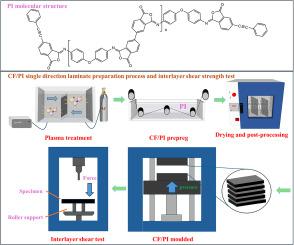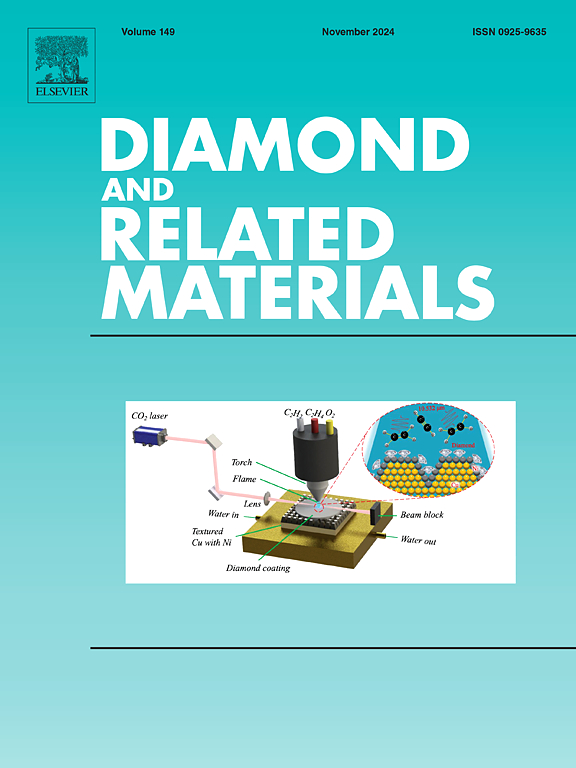氩等离子处理对室温和高温下碳纤维表面特性及其增强聚酰亚胺复合材料界面性能的影响
IF 5.1
3区 材料科学
Q2 MATERIALS SCIENCE, COATINGS & FILMS
引用次数: 0
摘要
在高温条件下,这会导致复合材料的机械性能发生很大变化。为了确定复合材料在高温下发生的结构和机械性能变化,阐明高温下的损伤机理,提高材料的稳定性和耐久性。本文研究了等离子处理时间如何影响碳纤维的表面极性、粗糙度、润湿性和机械性能。结果表明,等离子处理 10 分钟后润湿性最佳,纤维表面形成了新的含氧官能团(COO- 和 -C=O)。其根本原因是在等离子表面处理过程中,环氧树脂上浆剂成分中双酚 A 部分链段中的 CH 基团被氧化,形成有机氧化物层。本文利用等离子体改性技术改善了碳纤维与聚酰亚胺(PI)树脂的界面相容性,层间剪切强度达到 103.98 MPa,提高了 10.49%,300 °C 时的强度保持率为 84.3%。本文采用等离子体改性技术提高了碳纤维与 PI 树脂的界面相容性。研究发现,经过电感耦合等离子体(ICP)处理的碳纤维表面发生了物理和化学变化,有效提高了与树脂的界面相容性。但等离子体改性纤维表面的化学基团和物理蚀刻区域能够在一定程度上阻碍树脂的相对运动,从而提高界面强度。本文章由计算机程序翻译,如有差异,请以英文原文为准。

Effects of argon plasma treatment on carbon fiber surface characteric and its reinforcing polyimide composites interfacial properties at room and elevated temperatures
In high temperature conditions, this can cause considerable changes in the mechanical properties of the composite. In order to determine the structural and mechanical property changes that occur in composite materials at elevated temperatures, to elucidate the damage mechanisms at elevated temperatures, and to improve the stability and durability of the materials. This paper studies how plasma treatment time affects the surface polarity, roughness, wettability and mechanical properties of carbon fibers. The results showed that the best wettability was attained after 10 min of plasma treatment, and new oxygen-containing functional groups (COO- and -C=O) developed on the fiber surface. The fundamental explanation is that during plasma surface treatment, the C![]() H group in the bisphenol A part chain segment present in the epoxy resin sizing agent's composition is oxidized, forming an organic oxide layer. In this paper, the plasma modification technology was utilized to improve the interfacial compatibility of carbon fiber and Polyimide (PI) resin, and the interlaminar shear strength reached 103.98 MPa, up 10.49 %, and the strength retention rate was 84.3 % at 300 °C. In this paper, the plasma modification technique was employed to increase the interfacial compatibility of carbon fiber and PI resin. It was found that the Inductively Coupled Plasma (ICP) treated carbon fiber surfaces underwent physical and chemical changes that effectively enhanced the interfacial compatibility with the resin. However, the chemical groups and physically etched regions on the surface of the plasma-modified fibers are able to impede the relative motion of the resin to a certain extent, thus improving the interfacial strength.
H group in the bisphenol A part chain segment present in the epoxy resin sizing agent's composition is oxidized, forming an organic oxide layer. In this paper, the plasma modification technology was utilized to improve the interfacial compatibility of carbon fiber and Polyimide (PI) resin, and the interlaminar shear strength reached 103.98 MPa, up 10.49 %, and the strength retention rate was 84.3 % at 300 °C. In this paper, the plasma modification technique was employed to increase the interfacial compatibility of carbon fiber and PI resin. It was found that the Inductively Coupled Plasma (ICP) treated carbon fiber surfaces underwent physical and chemical changes that effectively enhanced the interfacial compatibility with the resin. However, the chemical groups and physically etched regions on the surface of the plasma-modified fibers are able to impede the relative motion of the resin to a certain extent, thus improving the interfacial strength.
求助全文
通过发布文献求助,成功后即可免费获取论文全文。
去求助
来源期刊

Diamond and Related Materials
工程技术-材料科学:综合
CiteScore
6.00
自引率
14.60%
发文量
702
审稿时长
2.1 months
期刊介绍:
DRM is a leading international journal that publishes new fundamental and applied research on all forms of diamond, the integration of diamond with other advanced materials and development of technologies exploiting diamond. The synthesis, characterization and processing of single crystal diamond, polycrystalline films, nanodiamond powders and heterostructures with other advanced materials are encouraged topics for technical and review articles. In addition to diamond, the journal publishes manuscripts on the synthesis, characterization and application of other related materials including diamond-like carbons, carbon nanotubes, graphene, and boron and carbon nitrides. Articles are sought on the chemical functionalization of diamond and related materials as well as their use in electrochemistry, energy storage and conversion, chemical and biological sensing, imaging, thermal management, photonic and quantum applications, electron emission and electronic devices.
The International Conference on Diamond and Carbon Materials has evolved into the largest and most well attended forum in the field of diamond, providing a forum to showcase the latest results in the science and technology of diamond and other carbon materials such as carbon nanotubes, graphene, and diamond-like carbon. Run annually in association with Diamond and Related Materials the conference provides junior and established researchers the opportunity to exchange the latest results ranging from fundamental physical and chemical concepts to applied research focusing on the next generation carbon-based devices.
 求助内容:
求助内容: 应助结果提醒方式:
应助结果提醒方式:


